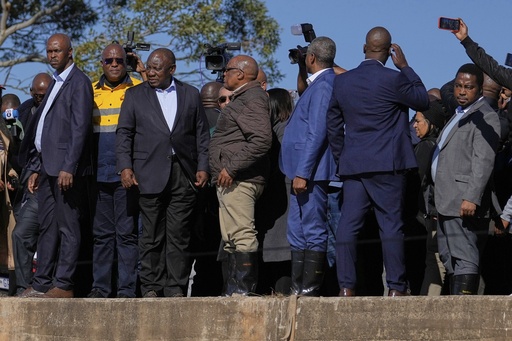In the aftermath of catastrophic floods in South Africa’s southeastern region, at least 78 individuals have lost their lives. Search and rescue missions pressed on for a fourth day, with officials anticipating an increase in the death toll. President Cyril Ramaphosa journeyed to Mthatha in the Eastern Cape province, the area most severely impacted since the onset of the deluge on early Tuesday.
During his visit, Ramaphosa engaged in a briefing with representatives from the National Disaster Management Center. He also surveyed a bridge where a school bus succumbed to the floods, tragically killing six students, the driver, and another adult onboard. An additional four students remain missing.
Questions have arisen about the efficiency of the governmental response to the disaster, sparked by an intense weather system characterized by torrential rain, powerful winds, and snow across parts of the province. Warnings about the impending harsh weather had been issued the previous week.
The head of Eastern Cape’s provincial government revealed that the flood response was initially “paralyzed” due to insufficient resources, notably the absence of specialized search and rescue teams, divers, and K-9 units, especially in one of South Africa’s impoverished regions. Premier Oscar Mabuyane noted that the province, home to 7.2 million residents, operates with only one designated rescue helicopter, which had to be sourced over 500 kilometers (310 miles) from a different city.
President Ramaphosa defended the government’s response, acknowledging the deep sorrow over the loss of lives but emphasizing that the situation “could have been much worse.”
Caught off guard in the pre-dawn hours, many individuals were swept away with parts of their homes and other wreckage as water inundated their residences. Authorities continue to comb through the floodwaters and remains of damaged structures in search of the missing, with several children counted among the deceased.
Zinathi Vuso, a Mthatha resident, recounted witnessing the harrowing scenes of people being washed away. “I need psychological help because I saw people dying in front of me,” Vuso expressed, recalling how some attempt to cling to objects, only for them to break. “That is why you are seeing people still getting recovered and others are yet to be found.”
Rescue teams have discovered bodies as far as 2 kilometers (more than a mile) from where victims were initially caught during the flooding. As rains have ceased and floodwaters recede, authorities urge residents to report missing persons to better grasp the scope of their search efforts. Cooperative Governance and Traditional Affairs Minister Velenkosini Hlabisa, who has been leading a national response team in the region, implored on national broadcaster SABC late Thursday, “We are in a crisis. A real disaster,” noting that the withdrawal of floodwaters might reveal more victims.
South Africa’s coastal regions remain susceptible to severe weather from the Indian and Southern Oceans. The floods in Eastern Cape, which echo past tragedies, notably the 2022 flooding in the Durban area that claimed over 400 lives, predominantly affected impoverished communities settled on floodplains close to rivers.



